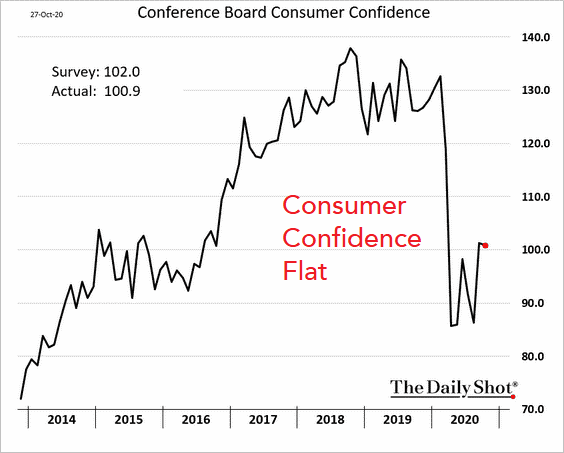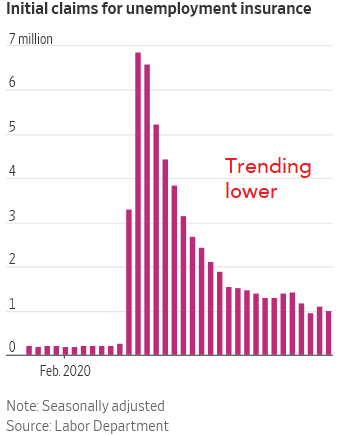Hello all – we hope you had a great November.
Stocks had a great month, too. The Dow saw its biggest monthly gain since 1987 with a rise of 12%. The S&P 500 and Nasdaq did well, too, but only had their best month since April. The S&P rose 11% while the Nasdaq was up 12%.
Stocks had a great month, too. The Dow saw its biggest monthly gain since 1987 with a rise of 12%. The S&P 500 and Nasdaq did well, too, but only had their best month since April. The S&P rose 11% while the Nasdaq was up 12%.
Here’s a look at the monthly performance of the Dow since 1987:
We can’t forget the smaller stocks. The Russell 2000 index is made up of small stocks and it had its best month ever with an 18% gain.
The gains in the markets look very healthy, too. Sometimes an index might be up because a few names had a very strong month and the rest of the index was mediocre.
However, of the 500 stocks in the S&P 500, 464 are up this month. That’s pretty rare and signals a healthy, broad-based rally.
However, of the 500 stocks in the S&P 500, 464 are up this month. That’s pretty rare and signals a healthy, broad-based rally.
______
Two main topics were responsible for much of the gains this month: The Presidential election and Coronavirus.
First, the election. It’s hard to believe the election was only a few weeks ago as it seems like an eternity.
The markets have been pleased with the result, which as it stands now, shows a Democrat in the White House and Republicans holding the Senate. This creates gridlock and prevents more radical elements of the Biden agenda from being implemented, particularly when it comes to business issues like taxes.
The market was also reassured by the personnel choices Biden has made to fill positions in the administration. For example, Janet Yellen as Treasury Secretary is someone we’re all familiar with and not controversial, like an Elizabeth Warren or Bernie Sanders would be in that position.
While the market is happy that these nominees are not from the extreme left, they are all solidly left. There’s also a lack of private experience in this group. Virtually every nominee comes from Washington or academia. A lack of understanding of business - or even outright hostility of it - could lead us back to the regulatory overreach we saw under the Obama administration.
First, the election. It’s hard to believe the election was only a few weeks ago as it seems like an eternity.
The markets have been pleased with the result, which as it stands now, shows a Democrat in the White House and Republicans holding the Senate. This creates gridlock and prevents more radical elements of the Biden agenda from being implemented, particularly when it comes to business issues like taxes.
The market was also reassured by the personnel choices Biden has made to fill positions in the administration. For example, Janet Yellen as Treasury Secretary is someone we’re all familiar with and not controversial, like an Elizabeth Warren or Bernie Sanders would be in that position.
While the market is happy that these nominees are not from the extreme left, they are all solidly left. There’s also a lack of private experience in this group. Virtually every nominee comes from Washington or academia. A lack of understanding of business - or even outright hostility of it - could lead us back to the regulatory overreach we saw under the Obama administration.
______
As for the Coronavirus, this month was very bipolar for virus news.
On one hand, the amount of new cases has risen sharply, although doubling the amount of testing in just the last two months may have something to do with this.
On one hand, the amount of new cases has risen sharply, although doubling the amount of testing in just the last two months may have something to do with this.
New lockdowns were issued in many states and cities and we’re seeing this have a negative impact on the economy. Unemployment is rising and many businesses are closing their doors for good.
On the other hand, several new vaccines were announced this month. Every announcement saw stocks soar on the news.
As for other news this month, nearly all the companies in the S&P 500 have reported their earnings for the third quarter and the results were far better than expected.
Analysts were originally expecting profits to fall over 20%, but the results stand at just a 6% loss. While a loss is not something to celebrate, it shows that the conditions out there are not nearly as bad as believed.
Analysts were originally expecting profits to fall over 20%, but the results stand at just a 6% loss. While a loss is not something to celebrate, it shows that the conditions out there are not nearly as bad as believed.
______
Economic data this month was mixed. As we mentioned earlier, shutdowns are causing businesses to close and people to lose their jobs. More people are now filing for unemployment.
Other economic data shows the economy is still strong and growing.
The service and manufacturing sectors are both expanding (a number over 50 means expansion):
The service and manufacturing sectors are both expanding (a number over 50 means expansion):
Retail sales are growing - though at a very low rate:
Durable goods, which are items with a longer life, look a little more promising:
People aren’t feeling as good about the economy. Consumer sentiment ticked lower last month and remains a long way from where it was before the virus.
Sentiment at small businesses has rocketed back from the virus lows, but stayed flat over the past month.
Where does the market go from here?
Stocks appear to be on the high side in the short term, based on the indicators we follow. That said, we aren’t too concerned with a large pullback here. While we think the odds of a rise are too low to put a large amount of new money in at this point, the market gains have been healthy and we wouldn’t be surprised to see markets grind higher. After all, December has historically been one of the best months for the indexes.
This commentary is for informational purposes and is not investment advice, an indicator of future performance, a solicitation, an offer to buy or sell, or a recommendation for any security. It should not be used as a primary basis for making investment decisions. Consider your own financial circumstances and goals carefully before investing. Past performance cannot guarantee results.
Stocks appear to be on the high side in the short term, based on the indicators we follow. That said, we aren’t too concerned with a large pullback here. While we think the odds of a rise are too low to put a large amount of new money in at this point, the market gains have been healthy and we wouldn’t be surprised to see markets grind higher. After all, December has historically been one of the best months for the indexes.
This commentary is for informational purposes and is not investment advice, an indicator of future performance, a solicitation, an offer to buy or sell, or a recommendation for any security. It should not be used as a primary basis for making investment decisions. Consider your own financial circumstances and goals carefully before investing. Past performance cannot guarantee results.



















































